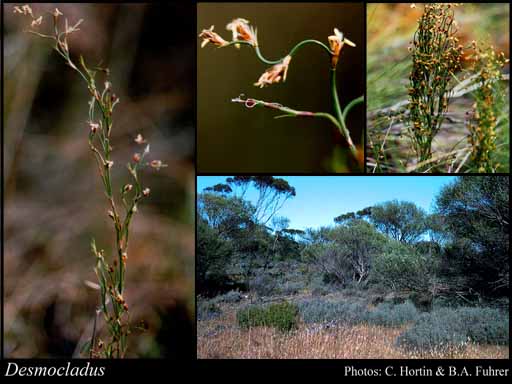- Reference
- Pl.Preiss. [J.G.C.Lehmann] 2(1):56 (1848)
- Name Status
- Current

Scientific Description
Family Restionaceae.
Habit and leaf form. Herbs; evergreen. Switch-plants; with the principal photosynthesizing function transferred to stems (culms). Leaves well developed, or much reduced (the blade being much reduced or absent). Perennial. Young stems cylindrical, or flattened (smooth or striate or tuberculate); not breaking easily at the nodes. Stem internodes hollow. Rhizomatous. Leaves alternate; distichous, or spiral; leathery, or membranous; sessile; sheathing (and more or less reduced to the sheaths). Leaf sheaths with free margins. Leaves simple; with a persistent basal meristem, and basipetal development. Vegetative anatomy. Plants with silica bodies. Leaf anatomy. Leaf blade epidermis conspicuously differentiated into ‘long’ and ‘short’ cells, or without differentiation into ‘long’ and ‘short’ cells. Guard-cells not ‘grass type’, or ‘grass type’. Stem anatomy. Secondary thickening absent.
Reproductive type, pollination. Fertile flowers functionally male, or functionally female. Unisexual flowers present. Plants dioecious (or rarely parthenocarpic). Female flowers with staminodes, or without staminodes. Male flowers with pistillodes, or without pistillodes. Floral nectaries absent (nectaries absent). Anemophilous.
Inflorescence and flower features. Flowers aggregated in ‘inflorescences’; in ‘spikelets’. Inflorescences scapiflorous, or not scapiflorous; terminal; spikelets solitary or in clusters. Flowers bracteate; bracteolate, or ebracteolate; cyclic. Perigone tube absent. Perianth of ‘tepals’, or absent; members when present, 1–6; 2 -whorled, or 1 -whorled; isomerous, or anisomerous; sepaloid. Fertile stamens present, or absent (when female). Androecium 3. Androecial members free of the perianth; free of one another; 1 -whorled. Androecium exclusively of fertile stamens. Stamens 3; becoming exserted; oppositiperianthial (opposite the inner perianth members). Anthers dorsifixed; versatile, or non-versatile; dehiscing via longitudinal slits; introrse, or latrorse; bisporangiate, or tetrasporangiate; appendaged, or unappendaged. Pollen shed as single grains. Fertile gynoecium present, or absent (male flowers). Gynoecium 1–3 carpelled. The pistil 1 celled. Carpels isomerous with the perianth, or reduced in number relative to the perianth. Gynoecium syncarpous; synstylovarious; superior. Ovary unilocular; 1 locular; sessile to stipitate. Gynoecium stylate. Styles 1. Ovules in the single cavity 1; funicled, or sessile; pendulous; non-arillate; orthotropous.
Fruit and seed features. Fruit non-fleshy; indehiscent; a nut (ovoid, with a conical stylar beak, shed with persistent pedicel and tepals if present); 1 seeded. Seeds copiously endospermic. Embryo weakly differentiated. Seedling. Hypocotyl internode absent. Mesocotyl absent. Seedling collar not conspicuous. Cotyledon hyperphyll elongated; assimilatory; more or less circular in t.s. Coleoptile absent. Seedling cataphylls absent. First leaf centric. Primary root ephemeral.
Additional characters Perianth of male flowers of ‘tepals’; (1–)5(–6) (the two outer tepals keeled). Perianth of female flowers of ‘tepals’, or absent; members when present, 1–5. Stems glabrous, or pubescent; branched (or with short lateral verticillate branchlets). Male spikelets 1-flowered to many-flowered (with numerous bracts, all fertile or lower bracts sterile). Female spikelets 1-flowered to several-flowered (usually with sterile lower bracts). Caespitose, or not caespitose. Female spikelets simple. Stem internodes with 1 central cavity. Leaf sheaths more than 3.